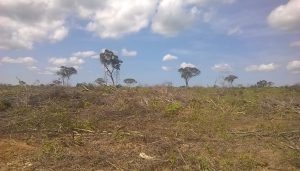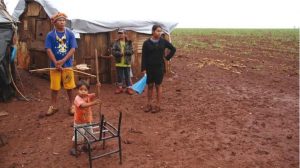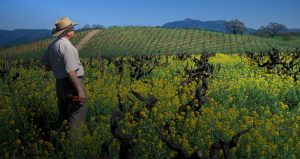On the occasion of the publication of the report Transnational Corporations and Land speculation in Brazil by Rede Social de Justiça e Direitos Humanos (Network for Social Justice and Human Rights), Mary Taylor of LeftEast spoke with Fábio Pitta, Devlin Kuyek and Attila Szőcs about the broader implications of their findings.
Mary: First, can you to speak a bit about the report. What are the the conditions of financialization of agricultural land and its consequences in Brazil?
Fábio: Financialization of agricultural land is not new in Brazil. It is related to the financialization of capitalism, since the 1970’s. David Harvey, François Chesnais, Robert Kurz (among others) have grasped this process, when the centrality or the mediation of capitalist society became dependent on the circulation of financial capital on global terms. Financial investment in farmland had an important shift at that moment in Brazil and it was related to the increase of external indebtedness of public and private debt of the Brazilian economy. Agroindustry developed there at that moment and the increase in farmland prices was explicit. Rolling over indebtedness was the logic of capitalist enterprise everywhere, and also in Brazil. In the 1990’s, with the Brazilian debt crisis and neoliberalism, agricultural expansion was very slow, and land prices decreased at that moment. That also allowed small agrarian reforms in the Brazilian countryside.
The main shift occurred after the 2003 bubble in commodity prices, that burst in 2008/2009, after subprime crisis in the USA. Between these bubbles , agroindustry in Brazil increased in area, production, and productivity (including soybean, sugarcane, corn, cotton and timberland). That increase promoted the expulsion of labor from the production process, generating structural unemployment (also called the crisis of labor) and raising the issue of how capitalism could accumulate over surplus value if all its production processes have less and less labor to be exploited.
Rolling over indebtedness throughout this financialization process changed into asset price inflation, the same character driving commodity prices all over the world, and real estate prices in the USA, Great Britain and Spain higher and higher. The logic of capitalist bubbles was at the core of the reproduction of (fictitious) capital.
Actually, the commodities prices burst was related to the subprime crisis, from the end of 2007 and onward. The logic of capital accumulation based on financialization / fictionalization of the economy and of everyday life is the logic that determines the world today, as capitalism is the only form of social relationship to exist on a global level.
The subprime crisis was the core of world economic crisis. People were buying new houses with their mortgages that had other houses as guarantees. There was credit to construct houses and credit to buy houses. This is fictitious capital sort of accumulation I was talking about before, with its asset price inflation logic of moving the economy. Even if there was the production of a merchandise with materiality (houses), it was all about “artificially” increasing house prices and renting over that. This process inevitably achieves a moment where the bubble bursts, the prices go downward, and we become inserted into forms of social barbarie connected with the social crisis of capitalism.
The so called fictitious increase in the area of agroindustry, production and productivity also drove the demand for new farmland, which was responsible for the increase in farmland prices. After 2008 / 2009, the search for farmland as a financial asset, as a financial investment detached from commodity prices. Commodity prices decreased at the same time land prices kept climbing higher because of the search for it.
What is new all around the world regarding this topic is that huge financial investors and huge agroindustries began to create join ventures to invest in land as a financial asset on its own. That had never happened before. Radar S/A, for example, is a joint venture between TIAA (USA pension funds) and Cosan S/A (The biggest Brazilian sugarcane, sugar and ethanol producer from Brazil). Radar S/A is exclusively a rural real estate company. Its only business is buying cheap land, waiting for the price to climb, and then selling it with “profit” (the conceptual term would be “financial rent”).
In the report mentioned earlier we have pictures from Radar S/A farms in the Brazilian Cerrado region that were bought and sold untouched, showing the speculative character of such business.

As the core of this sort of business has to do with financial logic, namely, buying cheap to sell expensive (land in this case), the search for the cheap creation of new farms through illegal land grabbing practices results in the eviction of rural communities, deforestation, huge environmental destruction, severe droughts and so on, to simply sketch a panorama. This conditions prevent communities to survive on the small pieces of land that they manage to keep for themselves.
Rural conditions for the social reproduction of communities and for workers are even worse nowadays. Wage workers and evicted communities can’t find any labor places (because of the industrialization of agriculture in the last 40 years) and because of competition between workers, labor conditions has worsened in the last years in Brazilian countryside. The situation is a tragedy.
MARY: Can you speak to how these conditions need to be understood as a global issue?
Devlin: What is happening in Brazil is connected to a global phenomenon that erupted after the financial crisis of 2008, as financial managers starting looking at farmland as a new asset class. The scramble to acquire farmland is also related to food security concerns in some import-dependent countries and the increasing industrialisation and corporate control of the global food system.

Fábio: I would suggest we consider the chapter in Saskia Sassen’s book“Expulsions” about the creation of a global rural land market after 2008. The phenomenon I described about capitalism’s shifts over the last decades and also the shift inside financial capitalism from rolling over indebtedness to asset price inflation enabled this very peculiar circumstance of the existence of a global rural land market, with financial investors searching for business all around, including Africa, Latin America and even inside the USA.
Attila: The issue of land has escalated a lot in Europe too. For more than a decade, the European Union and national authorities were looking towards the Global South, witnessing the massive land grabs done in African, Asian and South American countries, but land grabbing is escalating in our own backyard. Drivers include large scale monocultural farming, forestry, mining, energy, tourism, and ultimately speculation – and the process is weakening rural economies and hampering the development of a dynamic rural sector. In my country, Romania, after the fall of the communist regime where most of the land was in state control (dominated by an elite group of people), along with the privatization and liberalization of the land market, land has rapidly become the object of speculation and massive private investments. Regardless of the exploited resource, presently the land owned by Romanian peasants, who total almost 5 million people, is being grabbed and transformed with far reaching effects. Small-scale farms are rapidly vanishing. Statistics from the Romanian National Institute of Statistics show that approximately 150.000 small farms disappeared between 2002 and 2010. That is 3 farms per hour! It’s a massive transformation of our society, where, through land concentration or outright land grabbing, local food producers are dislocated from their rural areas and forced into migration and unemployment while 40% of agricultural land is already concentrated in the hands of a few private companies.
On top of that, most EU member state governments are escalating the development of neo-liberal agro-industry and making substantial efforts to attract multinational investments. We can witness structural policies moving towards very large scale, export-oriented agriculture fueling a global market. As millions of Eastern European peasant farmers and agroecological food producers are being marginalized, land is becoming merely a commodity on which companies can speculate. Just like in other regions of the world, land has become the new gold in Europe. Through this, the struggle for food sovereignty is getting much harder here too.
Mary: How do the structural conditions for these land grabs affect the way in which the land is used?
Fábio: I would say that the basis of these structural conditions are indeed the current asset price inflation of financial capitalism nowadays. That is responsible for a global competition to see how to produce commodities in industrialized manners. The only ones able to compete in this scenario are transnational global corporations. They can grow over the inflated prices of the commodities or over their own stock options prices in stock markets through indebtedness that has the same inflated prices as guarantees. While the prices keep climbing everything seems to be ok, but as with all financial bubbles, a burst will occur. The use of land to produce commodities or as a financial asset will happen within this worldwide logic.
Attila: Eastern Europe is an interesting case, as it has experienced a failed communism on one side, under which private lands of peasant farmers were forcefully expropriated and put under state run control and exploitation, and capitalism where in most cases land was re-privatized and competition was left at the mercy of the so called free-market. Both failed and the gradual disappearance of millions of Eastern European peasant farmers can be seen as a collateral damage of all these political and social experiments. Presently, land use is being rapidly transformed from being a resource supporting food production and rural stability to a financial asset and speculative commodity. This is best reflected by booming land prices all over Europe, but also the huge variation between prices, with 1 hectare of arable land in the Netherlands reaching EUR 63000 while the same hectare in Romania costs EUR1958 on average (Eurostat Newsrelease, 48/2018). Trick question: in which place would investment funds sitting on millions of EURO invest first under this scenario? Indeed, once lands have been transformed into an affordable speculative merchandise, land grabbing has unfolded rapidly in Eastern European countries like Romania.
This has led to a scene where multinational companies and investment funds have managed to accumulate a little less than half of the total farmland surface of the country. Indeed, several millions of hectares of land are controlled and put into the service of agroindustrial production or pure real-estate speculation.
Mary: The report exposes the way in which pension funds in North America and Western Europe are implicated in these land grabs, and contributes to the campaign to influence the investment practices of the TIAA (Teachers Insurance and Annuity Association) pension fund. I understand that these funds are in control of more investment capital than the largest hedge funds. This is quite interesting, as pension funds are quite often seen as a victory of the left. How can we think about the consciousness or praxis of workers who seek security in old age in precaritizing conditions and the effects of these funds on workers elsewhere?
Devlin: Pension funds are perhaps the most influential actors in today’s global financial system, with over $41 trillion in assets under management. If these pension funds decide

to allocate even just a small fraction of their portfolios to farmland, the impacts are huge. This is why we feel it is critical to apply pressure now, when most pension funds are still debating the merits of farmland as a speculative investment. In theory, since pension funds are based on worker contributions, these funds should be more susceptible to social and environmental concerns, and indeed many of them have guidelines for socially responsible investment, and some have even developed such guidelines for farmland. The reality, however, is that pension funds are deeply entrenched into the capitalist system. With farmland, this means that their investments will inevitably promote real estate speculation and bubbles, as well as industrial forms of agriculture, which are based on the exploitation of labour and the environment and corporate supply chains. The pension fund managers have zero interest in investing in small scale farmers and local food systems, and it’s hard to imagine how they could even do so.The guidelines can only mitigate the most egregious violations — but as we see in Brazil, even this is not happening.
This points to deeper questions around pension funds. In much of the West, pension funds were indeed a big victory for workers, but they have also played a dual role by supporting the growth and power of global finance, which has been hugely destructive to working people. And today, few workers have any pension security and most fall out of the defined benefit plans that were successfully fought for, and which people are today struggling to maintain. We are at a necessary moment where these two strands of activism have to converge: the struggle for a universal retirement system that provides adequate financial security to all of the elderly and a savings system that makes social investments in the interests of working people everywhere (including farmers).
Fábio: The end of the question is a very important issue. How can workers be responsible for overexploiting other workers? That‘s what the financialization of capital does. Everybody’s savings are driven into financial markets and financialization is at the core of productive enterprises because it has become necessary to fictionalize capital accumulation. That happens through the substitution of labor inside industrial production (robotization and autonomation after the 1970’s). Society’s savings are used as investments, as money in abstract sense. This sort of reality (workers overexploiting and evicting other workers) has to do with the core contradiction of capitalist society. We only can grasp that with critical theory and this is only a suggestion here. It is impossible, in this short opportunity, to scrutinize in a deep way the problems capitalism brings to society as a whole nowadays.
Attila: What I can add to the conversation started by Devlin and completed by Fabio is that in Eastern Europe, pension funds are still largely state-controlled. As outlined above, due to the political processes suffered by countries from this region, there is a blend

between capitalist and post-socialist approaches. Pension funds and other welfare services fall more under the latter one. So, as pension funds are still feeding the state budgets, rarely are political decisions made to put that money into land investments (largely also because the funds have barely enough to assure the actual purpose). On the other hand, Western Europe is a different story…one best illustrated by the case of the Dutch based multinational bank, Rabobank (discussed in Eco Ruralis Factsheet no. 7, March 2016). Through subsidiary companies belonging to a €315 million investment fund for farmland in Romania and Poland called Rabo Farm, Rabobank has acquired over 21,000 hectares of farmland across Romania since 2011, as part of a fifteen year investment which is expected to give returns of up to €900 million to investors. The investors are different pension funds like TIAA-CREF or APG ( Algemene Pensioen Groep) or PFZW (Stichting Pensioenfonds Zorg en Welzijn).
Mary: Given the “fiduciary responsibility” of pension funds, how limited is a divestment campaign? Wouldn’t funds just move into another set of high return investments? Is there some way to use these reports to question the financialization of everyday life more broadly?
Devlin: It’s not so much of a divestment campaign as it is an effort to prevent the financial industry from acquiring farmland. This can target laws at the local or national level that block corporations from buying farmland, as exists in a number of US states for example. It can also involve supporting organising efforts with local communities where the land grabbing is occurring, to make it more difficult for corporations to throw people off the land. But it can also involve what you might call “making noise”. This means exposing the pension funds that are involved in land grabbing, showing how their investments are bad for rural communities and the environment, and getting this message out as much as possible in the media and amongst their clients (workers). The idea is to scare off pension funds that are considering investing in farmland and to make it more difficult for TIAA and the other big pension fund managers that are spearheading the pension fund investments into farmland globally from attracting further investment. So it’s not a divestment campaign in the sense where we are just pleading with TIAA.
Fábio: I would agree with Devlin that divestment is only a strategy in a certain point. Land was one of the higher investments on the last years around the world. TIAA has almost 1 trillion dollars to invest in anything that brings good return. Funds are competing against each other and it has to do with capitalist society again and the merchandise form of relationship between people as the form of this society. I would say that there is no other way to criticize pension funds investments without giving emphasis to financialization of everyday life.
The more theoretical parts of the report have to do, again, with a global process in which everyone of us is inserted. To give just one concrete example. When Trump launched the Mother Of All Bombs (MOAB) in Afghanistan some months ago, the bomb’s producer (Raytheon) had a huge price increase in its stock options right away on the next day. Beyond this increase, they can contract (through indebtedness) new investments and produce more bombs. If we follow Jeremy Scahill’s assertions in his book “Dirty Wars”, this sort of “War on Terror” operations directly creates more terrorists, which increases the justification of more bomb attacks in a self moving and expansionist process. Financialization of capital is at the core of such a movement and it has the same social logic regarding investments in land, food or anything else.
In the text World Power, World Money , Robert Kurz relates what I called above the crisis of labor with the existence of a mass of superfluous empoverished people (capital enterprises are no longer able to overexploit the workers that need jobs to survive) all around the world. It is not only in the so called peripheries as we knew it some decades ago, but also inside what once were considered “developed countries”. The necessity of social repression is a promise that drives up stock option prices of military industry, refueling structural unemployment and overexploitation of labor and social exclusion.
Stephen Graham, in his book Cities Under Siege, shows how militarization is related to financial capital nowadays. Accumulation by dispossession is being used also inside the producers countries and against its “excluded citizens”. It is not only about foreigners, “terrorists”, but about internal repression.
Just to complete the argument, China’s (“socialist”) government is rating its citizens. The rating is about personal default, crimes, and other characteristics that can classify people as a sort of financial asset. This article in Portuguese talks about China forbidding citizens who score badly to use trains and airplanes. This is happening right now.
The most important case of the logic of asset price inflation and the impact of its bubble bursts on everyday life, in a worldwide sense, is the 2007/2008 subprime crisis, which started in the USA but spread to enterprises and other countries. Hedge funds went into bankruptcy, AIG, General Motors, Island, Greece, only to give some examples. When I was in Detroit in 2015, the impacts on families were very clear. People had bought houses with mortgages when there was lots of money to be lent, either to enterprises, either to families; either to construct houses or to fund families consumption. This whole process inflated house prices and allowed families to take out new loans on the inflated prices of their houses. The process refueled itself for a while. When the bubble burst families owed a lot of money, they lost their houses, and the price of the houses dropped precipitously. In Detroit, beyond the crisis in the historical city related to structural unemployment, I met people who owed more than $200,000, and even having paid more than one $100,000 still lost their houses, which at that time valued at $20,000. College loans, auto loans, and wealth insurance are also directly related to the asset price inflation logic I am trying to describe here.
Mary: Formerly state socialist Eastern Europe is subject to land grabs of this sort. Can you tell us about some cases and conditions and effects of these?
Attila: The geographical distribution of farmland grabbing in the EU is uneven and is particularly concentrated in eastern European member states. Here, the lack of transparency around large-scale land deals in the EU implies that farmland grabbing operates in part through ‘extra-economic’ forces and it involves a huge diversity of actors, including a new asset class made up of large banking groups, and pension and insurance funds, who are controlling an ever-increasing share of European farmland.
Our data shows that already more than 4 million hectares of land have been grabbed in Romania alone, with the strong presence of banking institutions and investment funds like Rabobank, Generali or Spearhead International. The range of investors is “exotic”…from Austrian Counts to Romanian oligarchs and Danish and Italian agribusiness companies. Eco Ruralis (Land Grabbing in Romania, 2015) argues that investors are mainly preoccupied with how to increase efficiency and how to financially develop. Labor conditions or local economic development are not of high importance for transnational companies. They grow vertically, usually controlling the full process of production all the way to export. Thus, small farmers are forced to reduce the price of their products to compete with highly profitable and subsidised businesses. As the possibilities in the countryside retract, many decide to sell out and leave their livelihoods behind.

Then there is the land grabbing unfolding in non-EU countries like Ukraine. Not being part of the EU, countries like Ukraine are left to face the corporate takeover that is unfolding after the fall of the Soviet Union alone. Besides the massive land control by the national oligarchy, which controls some 80% of the large mega-farms that are hundreds of thousand hectares, international trade deals recently under discussion only define who gets the leftovers ( to control and exploit agricultural lands).. Signing the EU partnership agreement also meant opening up the land market to the same actors that have been grabbing land in countries like Romania. A 2014 report done by The Oakland Institute also details the role of the World Bank and its International Finance Corporation in these massive land grabs. In the middle of all this, 7 million Ukrainian small farmers suffer and are left-out completely even from statistics, held crippled and left unable to participate in their own food market.
Whether in the EU or not, Eastern European countries and their millions of peasants currently face huge challenges and transformations. These are partially a result of the post-communist era and it’s “state land-grabs”, but mostly because they became a territorial hot-spot for private capital investments in search of rapid returns, while completely disregarding the major social, environmental and economic impact that they are generating. Due to the aggressive manner through which this land grabbing is unfolding, we can also call the region the Wild Wild East where everything is up for grabs and the last bastion of the resistance are the peasants and other rural communities.
Devlin Kuyek works with the international organisation GRAIN from his home in Montreal, Canada.
Fábio Pitta is Post-Doc researcher in Geography at the University of São Paulo, Brazil and works with the international organization Rede Social de Justiça e Direitos Humanos (Network for Social Justice and Human Rights).
Attila Szőcs is a land rights campaigner and coordination committee member of Eco-Ruralis a Romanian association of peasants and agroecological food producers. The mission of the organisation is to support agroecology and promote peasant family farming as the dominant, preferable method of agriculture in Romania. Eco Ruralis focuses to aid the capacity of peasants to collectively defend themselves against unfair and unequal actions taken by corporations and governments.

